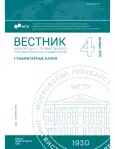Conceptualization of Pejorative Zoometaphors in American English Linguoculture
- Authors: Smurova O.V.1
-
Affiliations:
- Moscow State Linguistic University
- Issue: No 4(898) (2025)
- Pages: 87-93
- Section: Linguistics
- URL: https://journal-vniispk.ru/2542-2197/article/view/291916
- ID: 291916
Cite item
Full Text
Abstract
The article examines conventional zoometaphors with negative connotations functioning in American English linguoculture with the aim to study the cognitive mechanism of actualization of pejorative evaluative meanings in statements containing such metaphors. Based on the achievements of axiology and the cognitive theory of metaphor, the author describes the mechanism of zoometaphor formation and analyzes the interaction of evaluative and metaphorical meanings in an utterance. The following methods are used in the work: contextual analysis, cognitive analysis and the method of quantitative calculations. The research material is based on examples obtained by continuous sampling from the Corpus of Contemporary American English. The result of the study is the identification and substantiation of the cognitive mechanism of zoometaphor formation, which includes several stages and several types of conceptual projections.
About the authors
Olga Vladimirovna Smurova
Moscow State Linguistic University
Author for correspondence.
Email: olsmurova@yandex.ru
PhD (Philology), Associate Professor at the Department of English Grammar and the History of the English Language
Faculty of the English Language,
References
- Teliya, V. N. (1986). Konnotativnyi aspekt semantiki nominativnykh edinits = The connotative aspect of the semantics of nominative units. Moscow: Nauka. (In Russ.)
- Arutyunova, N. D. (1988). Tipy yazykovykh znacheniy: Otsenka. Sobytie. Fakt = Types of language meanings: Evaluation. Event. Fact. Moscow: Nauka. (In Russ.)
- Wolf, E. M. (2002). Funktsionalnaya semantika otsenki = Functional semantics of evaluation. Moscow: Editorial URSS. (In Russ.)
- Lakoff, G., Johnson, M. (1980). Metaphors we live by. Chicago: University of Chicago Press.
- Lakoff, G. (1986). Women, Fire, and Dangerous Things: What Categories Reveal about the Mind. Chicago & London: The University of Chicago Press.
- Lakoff, G., Turner, M. (1989). More than cool reason. A field guide to poetic metaphor. Chicago: Chicago University Press.
- Kövecses, Z. (2002). Metaphor: A practical introduction. Oxford: Oxford University Press.
- Kövecses, Z. (2014). Creating metaphor in context. International journal of language and culture, 1(1), 21–41.
- Sommer, R., Sommer, B. A. (2011). Zoomorphy: Animal Metaphors for Human Personality. Anthrozoös: A multidisciplinary journal of the interactions of people and animals, 24(3), 237–248.
- Stefanowitsch, A. (2020). Corpus linguistics: A guide to the methodology Berlin: Language Science Press.
- Radden, G., Kövecses, Z. (1999). Towards a Theory of Metonymy. In Panther, K.-U., Radden, G. (Eds.), Metonymy in Language and Thought (pp. 17–59). Amsterdam: John Benjamins Publishing.
- Ruiz de Mendoza Ibáñez, F. J., Díez Velasco, O. I. (2002). Patterns of conceptual interaction. In Dirven, R., Pörings, R. (Eds.), Metaphor and Metonymy in Comparison and Contrast (pp. 489–532). Berlin & New York: Mouton.
- Kuleshova, D. Yu., Smurova, O. V. (2024). Metaphorization Models of Evaluative Statements. Vestnik of Moscow State Linguistic University. Humanities, 8(889), 85–91. (In Russ.)
Supplementary files










